

Hermeticism. Not to be confused with Hermit.

Hermeticism, also called Hermetism,[1][2] is a religious and philosophical/esoteric tradition based primarily upon writings attributed to Hermes Trismegistus ("Thrice Great").[3] These writings have greatly influenced the Western esoteric tradition and were considered to be of great importance during both the Renaissance[4] and the Reformation.[5] The tradition claims descent from a prisca theologia, a doctrine that affirms the existence of a single, true theology that is present in all religions and that was given by God to man in antiquity.[6][7] Many Christian writers, including Lactantius, Augustine,[8] Thomas Aquinas[citation needed], Marsilio Ficino, Giovanni Pico della Mirandola, Giordano Bruno, Campanella, Sir Thomas Browne, and Emerson, considered Hermes Trismegistus to be a wise pagan prophet who foresaw the coming of Christianity.[9][10]
Hermética. History[edit] Early years and Hermética (1987–1989)[edit] The first songs composed by Iorio were "Sepulcro Civil", "Masa Anestesiada", and "Cráneo Candente".
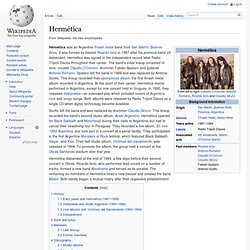
The band's first show was in a pub called "Helloween" in San Martín, on May 7, 1988. Although Horcas had been established before Hermética by Osvaldo Civile—a fellow member of V8—Hermética was the first of the two bands to perform a live concert. Spataro left the band in 1988 because of a labor dispute. Intérpretes and Ácido Argentino (1990–1992)[edit] Hermética performed many concerts at Cemento.
The band searchd for a new concert venue because the Arlequines was becoming too small for their growing audience. Following an avalanche at San Carlos Minas in January 1992, Hermética joined a charity music festival held at the Chateau Carreras stadium. Live albums and Víctimas del Vaciamiento (1993–1994)[edit] Hermetica. Scope[edit] The term particularly applies to the Corpus Hermeticum, Marsilio Ficino's Latin translation in fourteen tracts, of which eight early printed editions appeared before 1500 and a further twenty-two by 1641.[2] This collection, which includes the Pœmandres and some addresses of Hermes to disciples Tat, Ammon and Asclepius, was said to have originated in the school of Ammonius Saccas and to have passed through the keeping of Michael Psellus: it is preserved in fourteenth century manuscripts.[3] The last three tracts in modern editions were translated independently from another manuscript by Ficino's contemporary Lodovico Lazzarelli (1447–1500) and first printed in 1507.
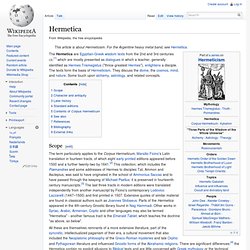
Extensive quotes of similar material are found in classical authors such as Joannes Stobaeus. Hermetic detector. In particle physics, a hermetic detector (also called a 4π detector) is a particle detector designed to observe all possible decay products of an interaction between subatomic particles in a collider by covering as large an area around the interaction point as possible and incorporating multiple types of sub-detectors.
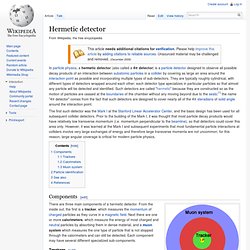
They are typically roughly cylindrical, with different types of detectors wrapped around each other; each detector type specializes in particular particles so that almost any particle will be detected and identified. Hermetic seal. A hermetic seal has the quality of being airtight.

In common usage, the term often implies being impervious to air or gas. When used technically, it is stated in conjunction with a specific test method and conditions of usage. The Hermetic Order of the Golden Dawn, Inc. Official logo of the Order History[edit] According to founder Chic Cicero, in 1977 he rented a house in Columbus, Georgia for sole use as a Golden Dawn temple,[2] he and his wife established an autonomous Golden Dawn temple there,[3] built a Neophyte Hall and Vault of the Adepti, and called the resulting temple Isis-Urania, "after the original London temple of Mathers, Westcott and Woodman.
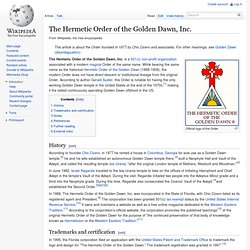
Hermetic Order of the Golden Dawn. The three founders, William Robert Woodman, William Wynn Westcott, and Samuel Liddell MacGregor Mathers were Freemasons and members of Societas Rosicruciana in Anglia (S.R.I.A.).[5] Westcott appears to have been the initial driving force behind the establishment of the Golden Dawn.

The Golden Dawn system was based on hierarchy and initiation like the Masonic Lodges; however women were admitted on an equal basis with men. The "Golden Dawn" was the first of three Orders, although all three are often collectively referred to as the "Golden Dawn". The First Order taught esoteric philosophy based on the Hermetic Qabalah and personal development through study and awareness of the four Classical Elements as well as the basics of astrology, tarot divination, and geomancy. The Second or "Inner" Order, the Rosae Rubeae et Aureae Crucis (the Ruby Rose and Cross of Gold), taught proper magic, including scrying, astral travel, and alchemy.
Influences[edit] History[edit] Cipher Manuscripts[edit] J.W. Hermetic Qabalah. Teachings[edit] Conception of Divinity[edit] A primary concern of Hermetic Qabalah is the nature of divinity, its conception of which is quite markedly different from that presented in monotheistic religions; in particular there is not the strict separation between divinity and humankind which is seen in monotheisms.[2] Hermetic Qabalah holds to the neoplatonic conception that the manifest universe, of which material creation is a part, arose as a series of emanations from the godhead.[3]
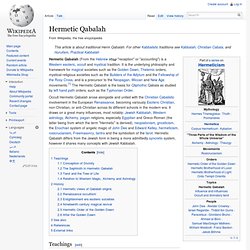
Hermetic.